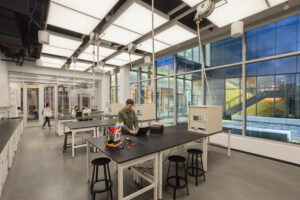Photo: The Georgia Institute of Technology’s Dr. Thomas A. Fanning Student-Athlete Performance Center in Atlanta, where the institution’s office of corporate engagement has secured nearly 15% of the campus research funding from industry, with corporations spending more than $70 million on research this fiscal year, up 28% from last year. | Image Credit: Danny Sandler, DPR Construction
By Michelle Martin
Colleges and universities across the United States are facing one of the most unsettled periods for capital planning and campus growth in decades. Rising material costs, shifting federal policies and political uncertainty are combining with financial pressures to delay, reduce or completely reshape projects. From laboratories and student housing to athletic facilities, essential initiatives are now caught in a cycle of volatility. This environment of uncertainty is leaving its mark on capital development across campuses. Leaders are being forced to rethink how they plan, budget and deliver new infrastructure to keep long-term priorities on track.
Building Research Facilities Despite Funding Cuts

Photo Credit: SmithGroup
Among the most significant forces shaping higher education construction is the decline in dependable federal funding for research.
Substantial reductions to major funding sources of the Department of Health and Human Services (HHS), especially the National Institutes of Health (NIH) and National Science Foundation (NSF), are prompting institutions to pause or phase projects that depend on federal funding to operate. Uncertainty in litigation outcomes compound the challenges in implementing capital programs. The effects are visible. Laboratories and research complexes require years of planning and are now being interrupted midway or scaled down.
“Novel discoveries happening within the walls of university research labs are essential in advancing innovation within the United States and globally. To ensure the continuation of these important research endeavors, university leaders are unlocking innovative funding and enrollment strategies,” said Greg Fraikor, Higher Education Core Market Leader for DPR Construction.
As legal battles around federal funding continue, institutions are implementing new strategies to fill the gap now. Research facilities not only house the research within but also attract the researchers, faculty and industry partners needed to secure funding. The top R1 institutions are already implementing new financing strategies such as selling bonds, restructuring their endowments, increasing case reserves and increasing enrollment numbers through higher acceptance rates, in part, to address the dwindling number of international students paying out-of-state tuition fees. Industry partnerships will be an enduring addition to university research funding with direct dollars allocated to research areas of private sector interest. Georgia Tech exemplifies this model of corporate engagement. As reported in Wall Street Journal, Georgia Tech’s office of corporate engagement has secured nearly 15% of the campus research funding from industry, with corporations spending more than $70 million on research this fiscal year, up 28% from last year. Transitioning from surviving to thriving will require a full suite of new strategies and tactics heading into 2026.
Rising Material Costs Encourage Phased Construction
Increased tariffs on steel and aluminum, and U.S. duties on Canadian softwood lumber rose in July and August. The result is higher costs for construction projects. To manage this environment, universities are increasingly embracing phased construction. By breaking projects into stages, they can spread out investment, hedge against cost swings, and maintain forward momentum. They’re also exploring design simplification and alternative material selection and supply sources. Institutions that bring construction and supply chain partners into the process early are having success in modeling escalations and planning sourcing options accordingly.
Endowment Tax Proposals Complicate Long Term Planning
Adding to the significant changes in university operations, the One Big Beautiful Bill Act’s new three-tiered endowment tax structure imposes a federal excise tax ranging from 1.4% to 8% for targeted institutions. Beginning in January 2026, the tax will significantly impact the top 20 endowments to the tune of over $10 billion over the next five years. Affected universities are taking steps to mitigate impacts through hiring freezes, cutting research costs, and, unfortunately, reducing access for lower- and middle-income students. As U.S. News & World Report noted, the American Council on Education’s assistant vice president of government relations, Steven Bloom stated, “… these schools are going to have to spend more money under the tax, taking it away from what they primarily use their endowment assets for — financial aid.” These early mitigation strategies allow institutions to develop scenario plans exploring the best options to pause, reduce, or sustain their current capital programs.
Read more about how to proceed through policy changes, and the 2026 outlook, in the Higher Education Issue of School Construction News.
Michelle Martin is a national higher education strategist at DPR Construction.


